The Global Gold Bull Market in Major Currencies
Commodities / Gold & Silver 2009 Jan 09, 2009 - 01:05 PM GMTBy: Zeal_LLC
 During late 2008's unprecedented financial-market panic, gold got something of a bum rap. Since this metal didn't soar during the stock chaos like most of its investors expected, many assume something must be wrong in gold-land. But gold ultimately did hold its own, up 2.1% in Q4 while the S&P 500 plunged 22.4%.
During late 2008's unprecedented financial-market panic, gold got something of a bum rap. Since this metal didn't soar during the stock chaos like most of its investors expected, many assume something must be wrong in gold-land. But gold ultimately did hold its own, up 2.1% in Q4 while the S&P 500 plunged 22.4%.
During the very heart of the stock panic when gold looked the weakest (under $750), it was being driven down by a bear-record US dollar surge. A mass exodus of flight capital fleeing the burning stock markets roared into US Treasuries for a temporary safe haven. Foreign investors joining this deluge had to buy dollars first, forcing a mighty dollar rally to erupt that traders interpreted as a sign to sell gold futures.
I discussed this temporary panic-driven dynamic in depth back in late October . But a knock-on effect of this episode was a great deal of distortion, both technically and psychologically. Like everything else, gold is denominated in dollars. So when an epic anomaly of a dollar surge snowballs extremely rapidly in a matter of weeks, it is really going to alter investors' perceptions of what is going on in the gold market.
Like a funhouse mirror, gold's technical action during the stock panic was a fleeting distortion of underlying fundamental realities . It is hard to understand what gold is really doing without first exiting the hall of mirrors. This means considering gold's Q4 panic action in its long-term context outside of the tyranny of the US dollar. This is especially challenging for Americans (me included) since we can scarcely think outside of our lifelong dollar framework.
Over the years I've tried to expand my own extra-dollar understanding of this secular gold bull by studying its progress in other major currencies. Since the stock panic's impact on gold seemed so confounding to those of us conditioned to think of gold only in US dollar terms, this week I decided to update our global gold thread of research. Did gold really perform as poorly as we Americans saw on our dollar-gold charts?
To find out, I built 10 gold-bull charts denominated in 10 different currencies. They all represent either globally-recognized elite currencies or relatively strong regional currencies used by large fractions of the world's population. Because local supply-and-demand dynamics can cause gold prices to vary a bit within each currency's sphere of influence, I used forex-implied gold prices rather than averaging countless series of local-currency gold-price data.
For the better part of a century now, the global gold trade has been dominated by the US dollar. This will change sooner or later thanks to the US Fed trying to destroy the dollar with exponential fiat-money-supply growth and zero yields, but it still holds true for now. Because of this, all over the world the prevailing gold price is a function of any currency's exchange rate with the US dollar along with the dollar price of gold.
In addition to the local-currency gold price rendered in blue, each chart shows that currency's exchange rate with the US dollar in red. If necessary I recast a currency's exchange rate out of its customary form so a rising red line always shows strength relative to the dollar and vice versa. In addition, for comparability all gold prices are units per troy ounce even if atypical in a particular currency's regime. As always, we'll kick off this exploration with the usual US dollar gold price as the baseline for other currency comparisons.
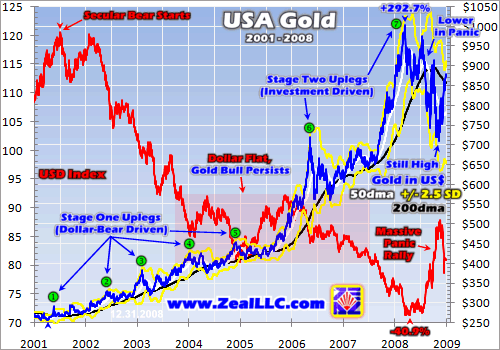
American gold investors can draw this chart from memory. It shows gold nearly quadrupling in US dollar terms since early 2001, a phenomenal bull over a 7-year span where the S&P 500 eked out a pathetic 11% gain! This bull has had two stages , which are quite distinct above. Initially in Stage One, gold was largely driven by the US dollar bear . But subsequently in Stage Two, investment demand usurped the dollar to gain gold's driver's seat.
Note the mighty Stage Two uplegs since mid-2005, both of which erupted while the dollar was relatively flat. And between early 2004 and late 2006, gold soared from the high $300s to the low $600s during a span where the US Dollar Index merely consolidated sideways. This was the transition between stages as investment demand took over from the dollar bear as gold's main driver. This emancipation of gold from the dollar's shackles is very relevant today.
Back in July 2008, the US dollar started rallying. It wasn't for fundamental reasons, but because the giant mortgage-backed bond industry was imploding and bond investors desperately sought the safety of US Treasuries. This kicked off the massive dollar panic rally in Q3, and the subsequent stock panic of Q4 accelerated it. Until this anomalous rally erupted, dollar gold remained strong in the high $800s and low $900s. As you can see above, all gold's panic weakness simply mirrored the dollar's unnatural strength.
At this dollar rally's apex on the very day the stock markets bottomed in late November, the US Dollar Index had reached levels first seen in early 2004 when gold was near $400 . Yet gold didn't even close under $700 in 2008's panic, vastly stronger than the dollar alone would suggest it should be. Once again this highlights the critical fact that the dollar is no longer gold's primary driver even though it can still temporarily influence gold at times.
Nevertheless, gold denominated in dollars still fell in the heart of the hyper-fearful stock panic. But gold's panic behavior certainly did not look like this for everyone. Many major currencies fell much farther than the dollar rose. This disproportionality drove local-currency gold prices to new bull highs. Gold's behavior during the stock panic may have disappointed Americans, but around the world it looked radically different.
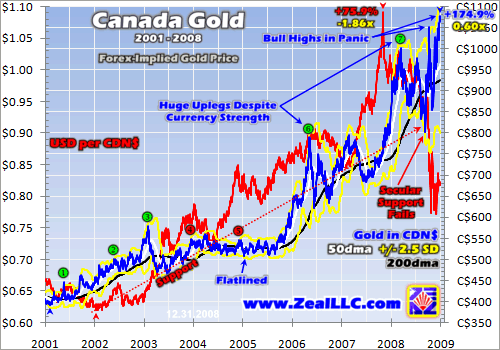
Canadian gold investors didn't have much to complain about. By early October, their local gold price had already exceeded its C$1003 high of March 2008 (marked with the green 7 above). The Canadian dollar fell so far relative to the US dollar that local gold surged despite all the dislocations in the global currency markets. The Canadian-dollar carnage in this panic was so bad that it shattered its bull's secular support that had held since 2003 .
By the end of 2008, Canadian-dollar gold was again hitting new bull highs. Up 174.9% since this bull began, gold has been a brilliant investment for Canadians this decade despite the bull market in their currency. This equates to 0.60x the gains seen in US dollar gold, as the yellow ratio under the blue gain above shows. And this is very impressive with the Canadian dollar's gains running 1.86x as large as the US dollar's losses.
So in Canada, as in much of the world, it wasn't gold that was weak during the stock panic but the local fiat currency. Considered from another angle, this means that gold's weakness in US dollar terms was actually modest relative to the US dollar's mighty gains on the global forex markets. Canadian investors saw a very different gold picture than we've seen in the States, as did those in South America's leading market.
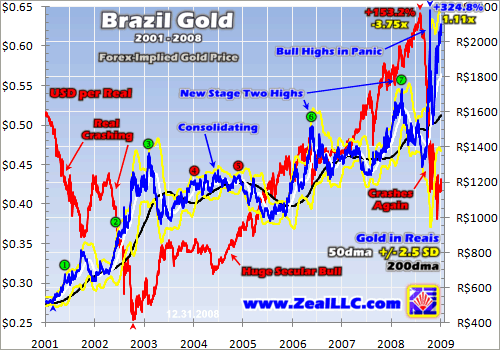
The Brazilian real fell so sharply during the stock panic that it looks like a crash on this long-term chart. Yet real gold remained very strong. Not only did it not break below its secular support, but it rocketed to new bull highs dwarfing those seen in March 2008. Incidentally, the tops of all the major US-dollar-gold uplegs are labeled in all these charts for comparison. Green numbers denote higher local-currency gold highs while red ones show lower ones.
The Brazilian real is a regional currency at best, and few investors would consider it strong despite its secular bull. Yet for much of South America, this is how gold's performance during the stock panic looked. This will drive all kinds of new South American interest in gold investing, as nothing sucks in new capital like dazzling performance. This is exactly what American investors wanted to see in October and November 2008, a blisteringly fast gold spike to radical new gold highs.
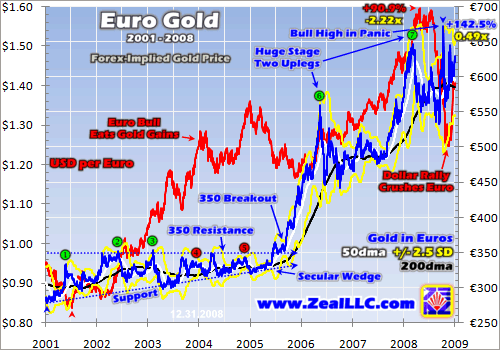
Unlike the Brazilian real, the euro is one of the strongest and best fiat currencies on the planet today. It too got hit hard by the anomalously intense dollar panic rally. But check out euro gold! Not only did it not fall far even during the stock panic's darkest days, but it soon surged to new bull highs above March 2008's! And even after hitting the mid-€600s right away in early October, euro gold hasn't given much back since. Even in late December as the stock panic faded, euro gold was still trading near its previous March highs.
In euro terms, gold's new mid-panic highs extended its secular bull since early 2001 to a fantastic 142.5%. This was in the face of a strong euro secular bull too, where the currency itself was up 90.9% at best. This just goes to show that even in the second-most-popular global currency, gold's bull has been outstanding. Since Stage Two dawned in mid-2005 and euro gold broke out above its old €350 resistance, gold has been one of the best investments for European investors to own.
In addition to Europe's 327m people who view gold through the lens of their euro, hundreds of millions of more people around the world use the euro as their primary currency. And this popularity will only grow as the dollar fades from prominence thanks to the Fed's madness. For this huge and growing block of investors that include ultra-wealthy Middle Eastern and Russian entities (including central banks), euro gold is how gold looked during the stock panic. And it is pretty darned impressive!
Euro gold's strong performance through the most difficult market episode in modern history will get many more euro users interested in gold investing. If I could pick a single chart to represent how gold really performed in the global stock panic in dollar-neutral terms, this euro-gold one would be it. American investors would do well to consider gold's recent performance in euro terms if we want to separate out the distorting effects of the enormous panic rally in the US dollar.
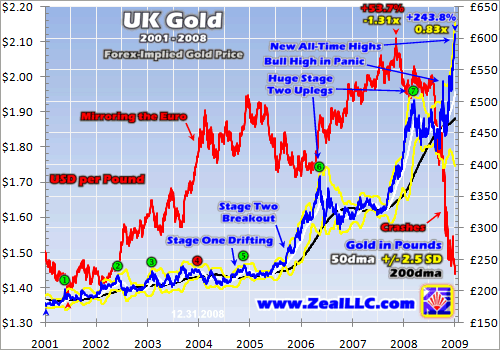
Britain remains a global financial powerhouse, with London still the world's financial capital in some markets including gold. Yet the stock panic seemed to affect investors holding assets in the pound sterling disproportionately hard. The pound essentially crashed during the dollar surge which drove pound gold up to dazzling new bull highs. How high? Pound gold rocketed to its highest prices seen since at least 1717 when records started being kept! You can't ask for better gold performance than this in a financial panic!
Provocatively this pound-gold price is extremely relevant. The pound is the third-largest reserve currency in the world today after the dollar and euro. It is also the fourth-most-traded currency in the world after the dollar, euro, and yen. These stellar gold prices are driving huge gold investment demand in Britain which ought to accelerate. The more average British investors realize how well their peers are doing in gold, the more capital they will invest in it. High and rising prices render assets extremely attractive to investors.
And since London is the center of the world gold trade, the pound-gold price's influence extends far beyond the direct users of this currency. A new gold rush in the UK could have a profound bullish impact on gold worldwide. It is fascinating to realize just how different investors who think in pounds perceived gold's stock-panic performance than those of us trapped in the fading US-dollar paradigm!
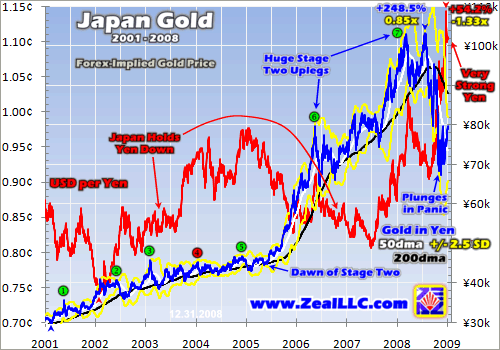
Out of all 10 major currencies, only Japan and China saw relatively poor gold performance similar to the States. In Japan's case, its government has been trying to drive the yen down in concert with the US dollar for years to help its massive export industry. Nevertheless, the yen got away from it during the stock panic. It just soared along with the dollar. There is no dollar-yen peg of course, and the yen's bull market started way back in mid-2007 a year before this latest dollar surge erupted.
Interestingly a sizable fraction of this yen strength occurred after the stock panic started abating in late November. This suggests the very weak yen-gold prices in late 2008 were partially the result of Japanese companies repatriating capital for year-end. In this chart you can see that the yen tends to rise late in most years. Regardless of its cause though, the average Japanese investor probably feels worse about gold's panic performance than we Americans do. This will not help gold investment demand in Japan.
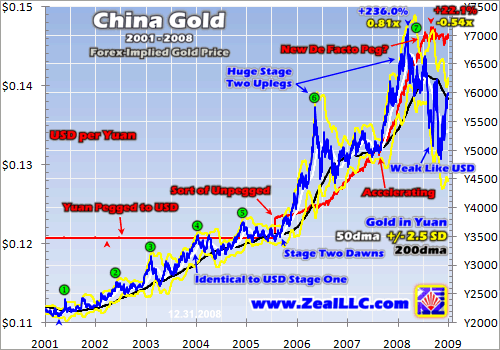
China saw similar poor panic performance. Of course the yuan was hard-pegged to the dollar until mid-2005, which is probably not incidentally right when Stage Two of the dollar-gold bull dawned. Since then the yuan has been rising in an accelerated fashion against the weakening US dollar. Provocatively though, since the middle of 2008 this yuan rise has suddenly stopped flat . This persisted through all the mid-panic currency turmoil too, which is extremely unlikely unless China has a new de-facto yuan-dollar peg.
Regardless of how managed this exchange rate has been in the last 6 months, it means the yuan-gold price looked nearly identical to dollar gold's. So Chinese investors certainly won't be impressed with gold's panic performance either. This is unfortunate since China is the world's biggest growth market for gold investment demand. On the bright side, when US dollar gold runs higher as its fundamentals suggest is inevitable, yuan gold will march higher in lockstep if Beijing tries to maintain this apparent new currency peg.
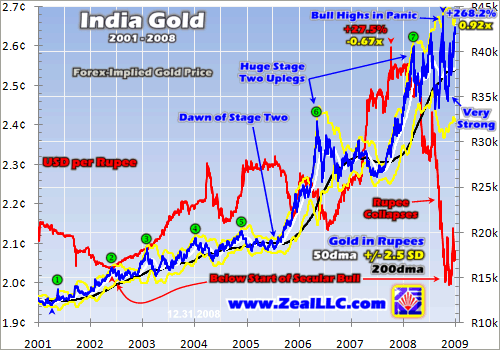
Of course Indians are collectively the world's biggest gold investor, so the rupee gold price is very important to the health of this global gold bull. Thanks to a rupee collapse during the stock panic to dismal levels underneath where its secular bull started in mid-2002, rupee gold has been very strong. In fact, it surged to new bull highs during the stock panic and ended 2008 near these levels. This will be very encouraging to Indian gold investors, especially since their own stock market was ripped to shreds by the global selloff.
During all this turmoil, India's deep cultural affinity for gold investment was strongly affirmed. Gold remained high and forged higher when all other assets were burning to the ground. It preserved and grew wealth even while the local currency utterly collapsed. This can only help future gold investment demand within the world's largest gold consumer. The rupee gold price is an important one to watch thanks to India's enormous influence in the global gold markets.
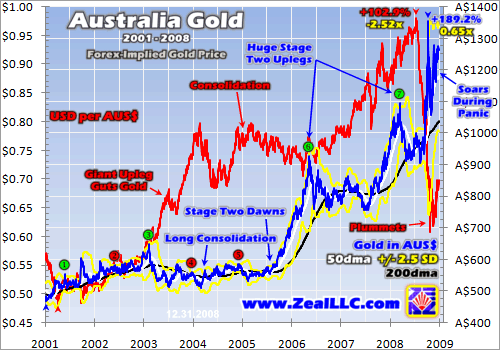
Similar to Britain, in Australia gold soared to radical new highs too. Even more impressive, it sustained stellar new levels leading into year-end even while the stock-panic fears rapidly bled away. This is dream performance for gold during a financial panic, just the kind of thing American investors hoped to see. With their natural-resource-heavy economy Australian investors have always been more open to gold investing than Americans, and these major new gold highs will only spur even bigger investment demand.
Also, like the euro, the Australian dollar has been in a powerful secular bull market thanks to the US dollar bear. Yet Aussie gold has still climbed 189.2% at best despite a 102.9% rally in the Australian dollar. And while you might think Aussie gold will collapse as the local currency recovers from its panic selloff, this isn't necessarily the case in Stage Two. If global investment demand drives up gold prices faster than the US dollar falls, highly likely, then gold in Australian dollars shouldn't give back much of its panic spike.
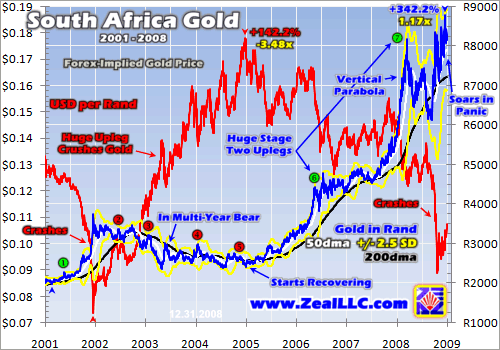
Not only is South Africa a top global gold producer, its currency is the most important in Africa. But this isn't saying much, as it has still been weak since early 2005 despite the US dollar bear. This has helped drive gold in rand up to the biggest bull-to-date gains seen out of all 10 of these currencies. Already weak, it shouldn't be surprising that the rand crashed yet again in response to the panic-driven US dollar rally. This drove gold to fresh new all-time rand highs which will encourage South African gold investment.
Ten charts is a lot to digest in one sitting, I know. But to understand how gold really did during late 2008's devastating stock panic, you really need to consider all these currencies concurrently. The takeaway is gold's panic performance ranged from excellent to spectacular in 7/10ths of these currencies which include the very important euro and British pound. Only the US, Japan, and China saw local-currency gold charts that looked weaker than investors hoped during the panic episode.
So unlike lamenting American gold investors, the great majority of the world's investors witnessed strong gold performance in recent months. Since demand for any investment grows with higher prices, gold investment should accelerate substantially in 2009 as global investors see how gold could have protected and grown their capital even while everything else was melting down around them. You couldn't hope for a better advertisement for the merits of gold investing.
The sharp US dollar rally that drove the poor gold performance in the US and China (and maybe Japan) was an unsustainable anomaly. Acute panic conditions generating extreme fear spawned it, but this fear is abating and those panic conditions no longer exist. And the US dollar is already reflecting this as its panic-driven rally started failing the day the US stock markets bottomed. As more flight capital emerges from its temporary hideout in US Treasuries, this dollar weakness will probably persist on balance.
For many structural reasons totally unrelated to the stock panic, gold's fundamentals remain awesomely bullish. Its strong performance during the stock panic in most of the world is only icing on the cake that will drive additional investment demand. And while gold itself is destined to head much higher in the coming years, the stocks of its producers should far exceed its gains. They were driven to ridiculously silly levels in the stock panic and have yet to properly reflect today's gold prices, let alone gold's future potential.
At Zeal we spent most of Q4 researching all the world's publicly-traded primary gold-producing stocks to find our favorites to ride the next big upleg in this secular gold bull. We summarized our hundreds of hours of research into a comprehensive fundamental report on our 12 favorite gold producers that was just published a few weeks ago. With gold looking so good and gold stocks remaining quite oversold, now is a fantastic time to deploy long-term capital in the world's elite gold stocks.
At just $95 (or $75 for our Zeal Intelligence monthly newsletter subscribers ), this deep 36-page report is a steal. Despite selling our private consulting time to clients around the world for $500 per hour, we have to turn away many more consulting engagements than we have the bandwidth to accept. If you commissioned us to do this report on a consulting basis, it would cost hundreds of thousands of dollars. But now you can get the same elite research for a tiny fraction of its true value. Buy your copy today !
The bottom line is gold's performance during late 2008's epic stock panic did not look anywhere near as bad to most of the rest of the world as it did to American investors. Unfortunately our dollar-centric worldview greatly distorted gold's true performance. It is a big mistake to read too much into dollar gold's recent technicals that were driven by an incredibly anomalous panic-driven dollar surge that is already reversing.
Rather than dampening investors' enthusiasm, gold's new bull highs achieved in the midst of the panic in much of the world will only accelerate gold investment demand. Post-panic, investors everywhere are much more conscious of risk and diversification. Increasing numbers will begin the time-honored best practice of always having some material fraction of one's total investment portfolio deployed in physical gold.
By Adam Hamilton, CPA
So how can you profit from this information? We publish an acclaimed monthly newsletter, Zeal Intelligence , that details exactly what we are doing in terms of actual stock and options trading based on all the lessons we have learned in our market research. Please consider joining us each month for tactical trading details and more in our premium Zeal Intelligence service at … www.zealllc.com/subscribe.htm
Questions for Adam? I would be more than happy to address them through my private consulting business. Please visit www.zealllc.com/adam.htm for more information.
Thoughts, comments, or flames? Fire away at zelotes@zealllc.com . Due to my staggering and perpetually increasing e-mail load, I regret that I am not able to respond to comments personally. I will read all messages though and really appreciate your feedback!
Copyright 2000 - 2009 Zeal Research ( www.ZealLLC.com )
Zeal_LLC Archive |
© 2005-2022 http://www.MarketOracle.co.uk - The Market Oracle is a FREE Daily Financial Markets Analysis & Forecasting online publication.



